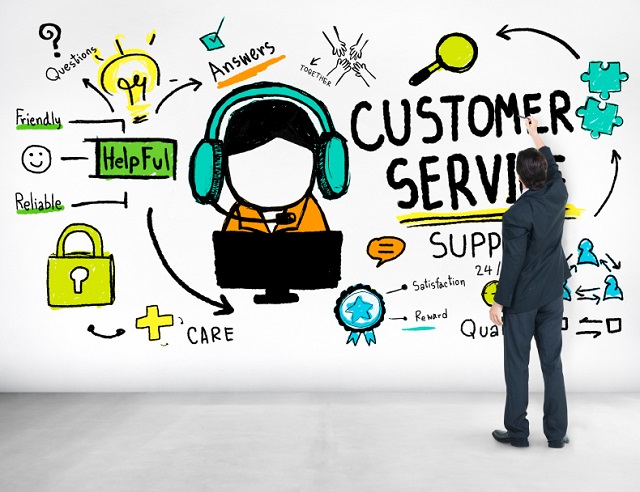
Do you have a lot of customer service inquiries in your business? If so, it can be a challenge to manage them all. Being responsive with customer service can make all the difference in your company’s success, so it makes sense to take a look at some tools that can streamline the process.
The most common solution to automating customer service inquiries is to implement a ticket management system, which is also called help desk software. Some of the things that are important to consider include:
- How fast you can respond to a customer
- How well you solve the customer’s problem
- How to track a customer’s issue if it has to be open for a while before it can be solved
- How to do all of this in a cost-effective and efficient, yet friendly, manner
These days, an inquiry can come from a multitude of places:
- Phone calls and voice mails
- Emails
- Text messages
- Social media accounts, for all the platforms you have a business presence
- Posts, replies, and comments
- Messaging
- Any other methods you have set up in your social accounts
- Chat feature on website
- Snail mail
That’s a lot of inputs to organize. When they can all be fed into the same system, you have just unified your messaging input and taken a giant step toward organizing all of these moving parts. A good ticketing system will accomplish this, and the feature you want to ask for is multi-channel accessibility.
Keeping your customer service costs low is another factor, and one way to accomplish that is to help users self-serve and solve their own issues when they can. This requires a robust knowledge base feature. A knowledge base is a set of how-to articles and videos of the most frequently asked customer service questions.
Here are a few very basic topics to consider including in your knowledge base:
- What forms of payment do you accept?
- What is your shipping policy?
- How can I get help if I need it?
- What is your return/refund policy?
- What is your privacy policy?
- What is your guarantee?
- Is my data secure with you?
- How do I update my credit card/address/phone/email?
- When will my items arrive?
- What licenses do you have?
- What are your hours?
- Do you have hours for seniors?
- How do I login?
- How do I access my digital items?
- What are your covid-19 policies for your employees? For customers?
- Are you hiring? How do I apply? What are your employment policies?
A good ticket system will also have the ability to customize the ticket, the customer service agents, the customer records, and the other important parts of the system. For example, you may want to set up your own status items for each ticket. Open, assigned, active, hold, and complete are typical status types, but you may need another one.
The workflow must also be considered in a ticket system. How does a typical ticket flow through your business, and can the system replicate that flow.
Other important features of a ticket system include:
- Support for multiple languages
- Customer response to tickets, as well as customers can view status of their tickets
- Uptime of system – service-level agreements
- Tracking, such as number of open tickets, tickets on hold, and the like
- Reporting metrics, such as wait time, ticket servicing time, and number of tickets handled by each agent
- Ticket tagging and categorizing
- Feedback loop for customer suggestions of product improvements
- Ease of use for customers and agents
- Notifications
A few of the most popular ticket management systems include:
- Zendesk
- Freshdesk or Freshservice by Freshworks
- Zoho Desk
- HubSpot Service Hub
- Salesforce Service Cloud
- LiveAgent
There are literally hundreds of technology options for any size business.
If you want to take your customer service to the next level or just want to get more organized, consider looking into these ticket systems.

Regardless of the type of relationship—personal, professional, or even acquaintance—communication is key. Communication is particularly necessary when it comes to customers and building a successful business. It’s even more important this year since many businesses have gone through so many changes. This article will help you achieve better customer communication.
Are You Communicating Properly?
Effective communication helps to ensure your product or service meets the customer’s needs and satisfaction. By meeting these needs and satisfaction, you are potentially generating repeat business. Start by figuring out what your customers are thinking and what questions they might have about your business.
Congratulate yourself if you’ve sent emails or posted notices on your website that answer the following questions:
- Have your hours changed?
- Has your location changed?
- Can you handle drop-in service?
- If so, is there a protocol? For example, do customers call a number when they get to your locked door? Will you be taking their temperature? Is a mask required?
- Is your business by appointment only?
- Then, how do customers make an appointment?
- Do you require a covid-19 test before an appointment can be made?
- Are there special accommodations for at-risk groups?
- Has your contact information changed? With people working at home, phone numbers may have changed.
- Have your services changed?
- Do you deliver?
- Do you offer curbside pick-up?
And this is just pandemic-related. You may have launched new products or services, changed prices, added staff, and implemented many more actions that customers should know about.
Tips on Effective Communicating
Here are some foundational reminders about communicating in business.
Connection
Communication starts with a connection. To give the customer what they want, you have to connect with them. If you can connect on a personal level, even better. Regardless, you need to convey to the customers that they—as well as their wants and needs—are important.
Listen
Listen to your customer—and listen well. Depending on the customer’s communication, you may have to ask very specific questions to better understand what they want or need. However, intently listening to your customers will allow you to form a better relationship with them.
Not only that, but you can get some great ideas for how to improve or create new products and services so that you fulfill even more of your customers’ wants and needs.
Understand
Now that you’re connecting and listening to you customer, make sure you understand them. If you don’t understand what they’re saying, ask them to clarify. This isn’t a guessing game, but a two-sided relationship. To give the customer what they want or need, you must understand what it is they are asking for.
Transparency
Be completely transparent with your customer. You cannot earn a customer’s trust or loyalty—or repeat business—if you aren’t one hundred percent honest with them. Tell the customer exactly what you can do for them; don’t promise something you can’t deliver.
Deliver
Make sure you can—and do—deliver exactly what your customer is expecting from you. If you promise to deliver something, whether it’s a service, product, or result, then you need to keep your word. In doing so, you will be laying the brickwork for a successful, long-term relationship.
Communication is one of—if not—the most important skill to have when it comes to connecting with your customers. After all, happy customers will come back.
 Congratulations, you’ve landed a new customer! Or, perhaps you prefer the term “client.” Either way, you should be excited; in this particular climate, sparking fresh interest in any kind of business can be challenging. Yet, you did it, and now comes the next part: What to do after you have officially landed that customer/client.
Congratulations, you’ve landed a new customer! Or, perhaps you prefer the term “client.” Either way, you should be excited; in this particular climate, sparking fresh interest in any kind of business can be challenging. Yet, you did it, and now comes the next part: What to do after you have officially landed that customer/client.
The following essential list of to-do’s will help ensure you not only keep your customer happy but that you KEEP them—period! Take a look; you will discover the list can apply to everyone and anyone.
- Welcome Your New Customer
A simple “thank you” goes a long way. Remember, with today’s competition, it is more important than ever to stand out. Nothing will help you stand out more than by showing appreciation to any new customers. Make sure to welcome them and thank them for choosing you/your business. This can be done in person, via card, or even email. Though, written form will likely make a lasting impression. Reinforce all of the benefits of choosing YOU!
- Make a Smooth Handoff
If you think about it, this new customer has joined your family—let them know that! Introduce them to your team (i.e. their new family and friends). Specifically, make sure they are acquainted with their person of contact and ensure it is a good fit by all involved parties.
- Get Them Onboarded in a Fun Way
During the initial meeting—orientation, if you will—give your customer all of the vital information they will need to easily navigate your business and get the most from your services. This information could include passwords to access certain areas, emails, phone numbers, a glossary of keywords, etc. If you could present this information in the form of a video, even better! Videos are much easier to understand and leave a lasting effect!
- Be Their New Best Resource (Goodies Added)
Do you have a new client kit? You should! This kit can include anything pertinent to the relationship with your new customer (i.e. relevant paperwork, files, contact information, etc.). Spice up this kit with some goodies, though! Everyone loves goodies. Make sure to properly read your customer to get a better understanding of their likes, but in general, these goodies could include candy and sweets, candles . . . You get the idea.
- Connect with Them on Social Media
Whether it is Facebook, Twitter, or Instagram, almost everyone is on at least one social media platform. Connecting on social media will not only allow you to know your customer/client better but is also a great way to network with “friends” of your customer.
- Meeting with the Customer for the First Time
There will come a point when you have that first review meeting with your customer. Be sure to deliver value and explain the service you’ve performed so far. The most essential take away from this step is that your customer feels comfortable and knowledgeable. This is a perfect time to verify any information that may seem unclear or complicated; encourage questions during this meeting.
- Ask for a Referral or a Review
The best way to drum up more business is word of mouth. You can ask immediately or want until your relationship has blossomed and become strong. Asking for a referral or a review (or both!) is completely acceptable and a good business practice.
Incorporating these seven items into your new customer onboarding process will get your relationship off to a great start. By showing your customer they are important, you stand a better chance of securing their future business and attracting even more potential customers.

 Setting expectations in your business is essential to gain the trust of your customers, avoid conflicts, and maintain a high level of customer service. One way to set expectations is to clearly state policies that are customer-facing. Many of these are accounting policies that we can help you with. The following policies are ones that every business should clearly publish.
Setting expectations in your business is essential to gain the trust of your customers, avoid conflicts, and maintain a high level of customer service. One way to set expectations is to clearly state policies that are customer-facing. Many of these are accounting policies that we can help you with. The following policies are ones that every business should clearly publish.
Refund Policy
When customers purchase your products or service and don’t get what they expect, what is their recourse? Your refund policy should clearly state which products and services are refundable. Do customers need to physically return the product in-store or via shipping? What if it’s a service? Are they refunded in cash or credit card? Or is it a store credit? Is there a deadline for refunds?
All of these questions should clearly be outlined in your refund policy. Your website is a great place to publish this information and an abbreviated form of your refund policy should be outlined on customer receipts.
Customer Complaints
If your customer has a complaint, how should they submit it? Is there a hotline to call, a suggestion box, or a form to fill out? If your business and employees are licensed, is there a government agency to write? A notice should be posted on your website and in your physical location describing where to submit complaints.
Shipping Policy
If you ship physical goods to a customer location, what is the cost of shipping? What is the expected delivery time? A shipping policy explains this as well as what can go wrong: If the item was never received, what should one do? Must you sign for a shipment? If you return a shipment, who pays the shipping? If an item is received damaged, how do you file a claim?
Payment Methods
What forms of payment will you take? If you take a check, what ID does the customer need to show? Do you take some of the newer forms of payment such as Apple Pay or cryptocurrencies? How do gift cards work?
Past-Due Accounts
If a customer doesn’t pay their bills on time, they should know what to expect. Will interest be charged? Will the account be sent for collections? Will someone break the customers’ legs? Will future purchases be cancelled or require a C.O.D. (cash on delivery) payment?
You might not think of your accountant when it comes to writing these policies, but you should; we can help. A good accountant can help you craft these customer service policies so that your communications and expectations with customers are better than ever.
With holidays approaching, this is the perfect time of year to take a moment and reflect on all of the things we are grateful for. Being grateful may sound a bit trite, but it’s also the number one, hands down, fastest way to bring more positivity and less negativity into your work and life.
Acts of gratitude are selfless and done unconditionally. You can use gratitude as a private exercise of reflection or you can express your gratefulness to show people that they are appreciated.
You don’t have to wait to feel gratitude; you can invoke it proactively.
If you don’t have a gratitude practice, consider starting one. Science has gotten involved in studying gratitude, especially in the field of positive psychology, and the benefits to health and well-being are enormous. It can benefit your business, too, when you show appreciation for business partners, employees, customers, and vendors.
Here are five easy ways to bring more gratitude into your work and life:
- Think of five clients you can send thank you notes to. You can write them by hand or send a greeting card with a thank you message.
- On your customer service email templates, add a line before the closing that says, “We appreciate your business.” It does make a difference.
- Quick, right now, think of five things you are grateful for and list them off the top of your head. After you’re done, you should feel a little bit happier than you did a few minutes ago. Use this tool after you feel a negative emotion to move you back into positivity faster.
- ________________
- ________________
- ________________
- ________________
- ________________
- Find part of your day that you don’t love, such as your commute to work. Change it to your gratitude commute, finding things along the way to be grateful for. You might be surprised how great you feel when you arrive at work.
- Let one of your employees know that you’re grateful for the work they do for you. You can do this verbally, with a note, or with a gift.
When you practice gratitude, you can’t help but feel happy for the things you have in your life. Try these five things on a regular basis to bring more gratitude and positivity into your work and life.
It’s always fun to surprise and delight your customers. This puts a smile on your client’s face, boosts loyalty, and is fun for your employees too. Here are five ways to surprise and delight your customers with inexpensive perks.
1. Handwritten thank you note.
Email and social media have all but killed the handwritten thank you note. So when you send yours to your top customers, it will really stand out.
2. Promotional items.
Promotional items are frequently handed out at trade shows, but they can be used in other settings too. These are items where your logo is typically imprinted and you purchase them in quantity. Items that are useful and popular include coffee mugs, t-shirts, fidget spinners, screen cleaners, webcam covers, key chains, notepads, calendars, and more.
Choose an item that is similar to or a reminder of your business or product. An IT consultant might choose a screen cleaner, while an accountant might choose a piggy bank.
3. Coupon bag.
If your business is located in a shopping mall or office building with other businesses around, go door to door and ask for coupons that you can put in a coupon bag to give to clients. Clients will be delighted to get a coupon for the dry cleaners, florist, and hair salon in your center no matter what type of business you’re in.
4. Random prize.
If your business has a stream of clients coming in a physical store or a virtual one, you can award prizes randomly to customers. If customers are grouped together as in a classroom or lecture hall, it’s easy – you can hold a drawing for a prize. Or you can select a random number and the customer assigned that number wins a prize.
Choose a prize from one of your services or products, or give something away that’s universal and “hot,” such as an Amazon Echo Dot.
5. Free samples.
The cosmetics industry has been giving away free samples and gifts with certain purchases for decades. Grocery stores often have free samples of food at a little booth staffed by a host at the end of an aisle. You might be able to apply this idea to your business with a little bit of creativity.
Think of how you can “sample” your service or product and package it up in a free gift or sample. If you offer a service, you may have to get extra creative. A consultant can offer a book that’s related to the service offered, a spa can have healthy treats while clients wait, and a divorce attorney can offer stress balls or fidget spinners.
With customer service declining in many businesses, try these five things to wow your customers and set your business apart.

It’s the little things that add up to make an exceptional experience for your customers. Here are five “little things” you can add to your services to create an exponentially memorable connection with your customers.
Generosity
Add a little extra something to the products or services you offer. It could be a piece of chocolate like Hershey’s® Kisses®. It might be a handwritten thank you note. It could be a coupon for their next visit. It could be a bottle of water.
These little additions pack a huge wallop for the customer experience. And none of them cost a lot to implement (unless you eat all the Hershey’s® candies yourself). Think of what you can add to your customer experience so that the customer sees you as generous and caring.
Speed
Many customers value their time, and adding speed to your service will be appreciated. When customers call in or email you for a service question, how fast do you respond?
Set response time goals for you and your employees to respond to customer issues and questions. You might choose one minute, four hours, or one day for response time, depending on your business. Make sure customer emails are answered first, and have someone monitoring the phone during business hours.
Track your results and reward your speediest employees.
Acknowledge and Apologize
Sometimes things go wrong, and an apology to the customer is in order. In most cases, customers simply want to be heard, so your listening skills are your best asset at that moment.
As an entrepreneur, the buck stops with you. Even though it might not have been your fault, it’s sometimes a good idea to simply apologize in the sincerest way possible. If there’s something that needs to be done to make it right, go overboard. Give the refund, take the loss, and let the customer win.
Positive Communications
How you word things can make all the difference. Which sounds nicer?
“That item is out of stock and won’t be in for six weeks.”
“We will have that item in stock in six weeks.”
The first sentence has two negatives (out of stock and won’t), while the second sentence is positive. It avoids the negative wording.
It’s a small but powerful change in the customer experience. Think about how you can word your communications so that there are more positive words and fewer negative words when speaking with customers.
Your Full Attention
Although you want to respond to customer issues with speed as mentioned above, while you are working with the customer, take time to slow down and really engage with the person. Our world is so fast, and some companies even reward multi-tasking, but no customer appreciates interruptions when being helped.
When you are with a customer, even on a phone call, be with the customer. Avoid interruptions and distractions, and give them your full attention. It’s the most powerful thing on this list. Treat them as a real person, not just another figure, and the customer will notice.
Try one or more of these five customer service boosts to take your customer service experience to the next level.
Online marketing is a large component of marketing for many small businesses. There are many aspects to online marketing that you’ll want to consider for your business. Here are just five for your consideration.
Content Marketing
Content marketing is huge, and it consists of generating articles, blog posts, social media updates, white papers, videos, and other educational materials about your company’s products and services. Content marketing provides your prospects with something to read, watch, or learn from.
You can offer your content via your website, social media pages, a special landing page, in a blog, in the description portion of your profiles, via paid ads, or almost anywhere online. Your content should promote your brand as well as show your prospect how to use your product or service.
Video
Video has become incredibly important. It’s no longer enough to generate text. Graphics are better than text, but video trumps them all when it comes to effectiveness, higher search rankings, engagement, and sales conversions.
The good news is you don’t have to hire an expensive video team anymore. A good video camera is less than $500, and you can also use your smartphone for some very decent footage.
Directories
It’s no longer enough to simply have a website. Being listed in online directories will help your business expand its visibility. Some common directories for small business include:
- Yelp
- Angie’s List
- Manta
- Better Business Bureau
- Yellow Pages (online version)
- Thumbtack
- Your local Chamber of Commerce
- Craigslist
- Google for Business (Google Places)
Some of these directories work best if you ask customers to post reviews. Be sure to also check out your industry-specific directories.
Social Media
Including social media in your digital marketing is a no-brainer today. Graphic and video posts are far more effective than text posts, so it’s important to make this content switch if you haven’t already.
If you’ve focused on the “big 3” platforms – LinkedIn, Twitter, and Facebook – it might be time to try some new ones. Pinterest and Instagram lend themselves to graphic representation of your product. Google Plus is often overlooked but can help search engine rankings. And YouTube is a must because of the importance of video.
Public Relations
Digital public relations has been around for a while as well. If you don’t already have a Press page on your website, consider this addition. It can list contact information for reporters as well as a list of articles that your product, company, or employees have been featured in. You can also post press releases to this page.
Distributing press releases is less expensive than ever with options such as PRWeb and PRNewswire.
Make sure your digital marketing campaign has all the components above and that you have updated your content for these latest trends. Having an up-to-date digital campaign will help you generate more revenue and grow your business.
Are you interested in being known for your extraordinary customer service? Or perhaps you just want your customers to feel like it’s easy to work with you or purchase from you. If so, try these five tips for five-star client service.
1. A good old-fashioned handwritten thank you note.
Almost extinct, this customer pleaser shows you are willing to go the extra mile for a personal touch and connection with your client. You can purchase boxes of thank you notes from any stationery store or order them with your company logo from a local printer.
2. Remember your customer’s preferences.
High-end hotels are good at remembering what you like, and almost any business can add this idea by using a CRM – customer relationship management system – that stores customer preferences, order history, last conversations, and any notes you want to remember about the client. The trick is keeping the system notes updated and using them when it counts.
3. Deliver an unexpected extra.
When your customer least expects it, give them more than what they paid for. This manifests itself in many ways, depending on your business type. Here are some examples:
- Restaurants: Give an appetizer, dessert, or coffee at no charge or pick up the bill of a regular once in a while.
- Retail or offices: Offer an unexpected beverage and fruit tray or snacks like you would find at a spa or country club.
- Real estate: Provide a list of local phone numbers, a fancy map or GPS app, or coupons to restaurants you partner with.
- Construction: Offer a tool, a warranty, a list of reliable repairmen, or a full set of replacement lightbulbs.
- Landscaping: Offer a birdfeeder, a fertilizer schedule, or a lawn tool.
- Any office: Partner with a business that has your same client base and exchange coupons so that you have a book of them to give to all your clients.
4. Give clients your cell number.
Giving clients your personal or business cell number is not as risky as you might think. Very few clients will actually call you. Surprisingly, the goodwill you gain by sharing your personal number far outweighs any disruption. But here’s a warning – don’t share your number with sales reps of vendors; you’ll get relentless calls every day from them.
5. Offer a VIP membership.
Some customers care about and are willing to pay more for excellent service, and others don’t. Separate your customer base by offering a VIP membership. By paying a nominal fee each year, these members get priority access to your appointment time, sales, overnight shipping, or whatever else you can distinguish. The good news is it’s a new revenue stream as well.
Choose one of these ideas and implement it to increase your customer service to five stars.
Providing great service can make a huge difference in a small business. For companies like Zappos, Nordstrom, and Southwest Airlines, customer service is a differentiator from their competitors. Done right, good customer service can bring lots of referrals that lead to increased revenue. Here are five tips to improve service to your customers.
1- “Welcome Home” Greeting
Consider your business as your home and your customers as invited guests. No matter how they come to you, whether by phone, email, or in person, greet them like you would a guest. If your business has a storefront and customers walk in, have your employees greet them immediately with a welcome message that ends in “Please, make yourself at home.” If your prospect or customer calls you, greet them warmly with “I’m so glad you called.” If a customer or prospect emails you, personally email them back (no autoresponders) to let them know you received their message and when you will be replying.
A warm welcome every time your customer contacts you will make them feel important.
2- Throwback Thank You Cards
Be old-fashioned for a change and handwrite thank you cards to your top clients. You can get blank folding cards with matching envelopes from your local printer or paper shop and have your company logo printed on them. If you don’t have time for that, consider SendOutCards.com.
3- Apologize
Things are bound to go wrong. Be quick with a heartfelt apology whether it’s your fault or not. If your customer struggled with anything – your website, shopping cart, store display, out-of-stock item, and so on – teach your employees to apologize first, then own the problem and get it fixed for all future clients. You can also teach them the language, “thank you for giving us the opportunity to fix this for all future clients.”
4- Mystery Shop
Periodically hire a mystery shopper to evaluate the customer experience at your business. These customer service experts will provide you with a list of suggestions, from your initial voice mail recording to paying your bill. Everywhere your business touches a client should be streamlined, easy, and sealed with a smile.
5- Listen
Your customers can be the best source of ideas for your next new revenue stream. Listen to their feedback and incorporate their ideas into your business.
Try these customer service tips to delight your customers, and watch your revenue grow.
 New Business Direction LLC
New Business Direction LLC